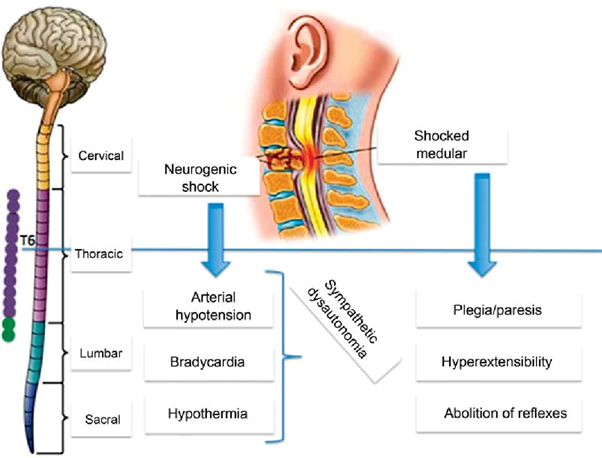A 40-year-old female patient with massive trauma and possible spinal cord injury is admitted to the emergency department (ED). The nurse suspects that the patient may be experiencing neurogenic shock in addition to hypovolemic shock, based on which one of the following?
Cool, clammy skin.
BP of 82/40 mm Hg.
Heart rate of 48 beats/min.
Shortness of breath.
The Correct Answer is C
Neurogenic shock is a type of distributive shock that occurs due to the loss of sympathetic nervous system tone after a spinal cord injury or other traumatic brain injuries. This loss of sympathetic tone leads to vasodilation and decreased systemic vascular resistance, resulting in inadequate perfusion to vital organs.
One of the hallmark signs of neurogenic shock is bradycardia (a heart rate less than 60 beats/min) due to the unopposed parasympathetic activity. The parasympathetic system becomes dominant when sympathetic activity is impaired. Therefore, a heart rate of 48 beats/min in this patient suggests the possibility of neurogenic shock.
A. Cool, clammy skin in (option A) is incorrect because Cool, clammy skin is a characteristic of hypovolemic shock, where reduced blood volume leads to vasoconstriction to redirect blood flow to vital organs.
B. BP of 82/40 mm Hg in (option B) is incorrect because: Hypotension is a common finding in both neurogenic shock and hypovolemic shock. A low blood pressure reading alone does not specifically indicate neurogenic shock.
D. Shortness of breath in (option D) is incorrect because Shortness of breath is not specific to neurogenic shock but can occur in various types of shock, including hypovolemic shock. It may result from inadequate oxygenation or impaired respiratory function due to the underlying condition or associated injuries.
Therefore, the heart rate of 48 beats/min suggests the possibility of neurogenic shock in addition to hypovolemic shock in this patient.

Nursing Test Bank
Naxlex Comprehensive Predictor Exams
Related Questions
Correct Answer is B
Explanation
Assessing tissue perfusion is crucial in evaluating the adequacy of oxygen and nutrient delivery to the body's tissues. While multiple factors contribute to tissue perfusion, the options provided in choice B are key indicators:
Level of consciousness: Altered mental status or changes in the patient's level of consciousness can be a sign of impaired cerebral perfusion, which reflects overall tissue perfusion.
Urine output: Monitoring urine output provides information about renal perfusion and kidney function. Decreased urine output can be indicative of inadequate tissue perfusion.
Lactate level: Lactate is a by-product of anaerobic metabolism that accumulates when there is insufficient oxygen delivery to tissues. Elevated lactate levels indicate tissue hypoperfusion and cellular oxygen debt.
A. Pupil response, pulse pressure, and urine output in (option A) are incorrect because While pupil response and pulse pressure may provide some information about perfusion, they do not encompass a comprehensive assessment of tissue perfusion. Additionally, assessing urine output is important, but it alone may not provide a complete picture of tissue perfusion status.
C. Blood pressure, pulse, and respirations in (option C) are incorrect because Blood pressure, pulse, and respirations are important vital signs to monitor, but they do not solely indicate tissue perfusion. Hypotension, for example, can be a late sign of inadequate tissue perfusion.
D. Breath sounds, heart rate, and pupil response in (option D) are incorrect because: Although breath sounds and heart rate can be affected by changes in tissue perfusion, they are not specific or comprehensive indicators of tissue perfusion status. Pupil response alone does not provide a complete assessment of tissue perfusion.
Therefore, the most accurate assessment of tissue perfusion in a patient in shock involves evaluating the level of consciousness, urine output, and lactate levels.
Correct Answer is D
Explanation
In septic shock, prompt administration of antibiotics is crucial in order to target the underlying infection and prevent further progression of the septic process. Antibiotics help to eradicate the causative organisms and reduce the bacterial load, which can help improve patient outcomes.
While all the options mentioned are important interventions in the management of septic shock, initiating antibiotic therapy is considered a priority in order to address the underlying infection and prevent sepsis-related complications.
A. Giving a 2000 mL normal saline bolus in (option A) is incorrect because: Fluid resuscitation is important in septic shock to restore intravascular volume, but antibiotic therapy takes precedence as it directly targets the underlying infection.
B. Starting an insulin drip to maintain blood glucose at 110 to 150 mg/dL in (option B) is incorrect because Glycemic control is important in septic shock, but it is not the first priority compared to addressing the infection.
C. Giving acetaminophen (Tylenol) 650 mg rectally in (option C) is incorrect because Antipyretic medications can help reduce fever, but they do not address the underlying infection or stabilize the patient's condition.
E. Starting norepinephrine (Levophed) to keep systolic blood pressure >90 mm Hg in (option E) is incorrect because: Vasopressor support may be necessary in septic shock to maintain adequate blood pressure, but initiating antibiotics takes priority in order to address the underlying infection.
Therefore, in a patient with septic shock presenting with the given signs and symptoms, the nurse should first implement the intervention of giving the prescribed antibiotics to target the underlying infection.
Whether you are a student looking to ace your exams or a practicing nurse seeking to enhance your expertise , our nursing education contents will empower you with the confidence and competence to make a difference in the lives of patients and become a respected leader in the healthcare field.
Visit Naxlex, invest in your future and unlock endless possibilities with our unparalleled nursing education contents today
Report Wrong Answer on the Current Question
Do you disagree with the answer? If yes, what is your expected answer? Explain.
Kindly be descriptive with the issue you are facing.
